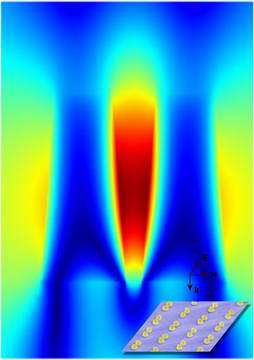Magnetic fields revealed in technicolour

Vibrations of magnetization have for the first time been captured on camera by scientists at The University of Manchester revealing a rainbow of colours.
For the first time, images of induced magnetic pulsations at the frequency of visible light have been captured - as reported in Nature (17 November, 2005).
The colours are produced when a new type of material, created by the research team, is exposed to light. The magnetic vibrations induced in the material are so strong that they change the colour of the material from yellow to green. Such vibrations are supposed to be impossible in a natural medium.
The artificial material, created in collaboration with Chernogolovka Institute of Microelectronics Technologies (Russia) and Aston University (UK), has 'unnatural' optical properties and could be the precursor of a 'perfect lens', focusing images to show features smaller than the wavelength of light itself. It is based on Professor John Pendry's (Imperial College London) idea of generating the magnetic response in nonmagnetic composites.
Dr Alexander Grigorenko, of the University's School of Physics and Astronomy and Manchester Centre for Mesoscience and Nanotechnology, who led the research, said: "This discovery could be a milestone for optics and could help to realise the visible-light left-handed materials which promise the perfect lens. It also provides wherewithal for making new optical devices such as spasers and nanolasers."
The nanofabricated material was created by covering a glass plate with pairs of tiny gold pillars, each about 100 nanometres high. It was found that as light interacts with the structures, the induced currents create magnetic vibrations inside the pillar pairs and alter reflection properties, unlike a normal piece of gold. The research shows that negative permeability - a necessary condition for achieving a left-handed material - is indeed possible for visible light waves.
Dr Igor Khrushchev of Aston University, a specialist in optoelectronics, added: "The proposed structures could enjoy a variety of applications in optoelectronics and serve as optical signal processors, modulators, selective filters and antireflection coatings."
Potential applications of the materials and their unique properties include: smaller and smarter optical lenses, miniature lasers that can be built in computer chips and ultra-sensitive chemical and bio-detectors.
Source: University of Manchester
















